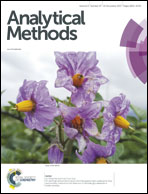Application of a glassy carbon electrode modified with carbon black nanoparticles for highly sensitive voltammetric determination of quetiapine
Abstract
A novel highly sensitive voltammetric quetiapine fumarate (QF) sensor based on a glassy carbon electrode (GCE) modified with carbon black nanoparticles (CB) was successfully developed. The electrochemical behaviour of the modified electrode and electrooxidation of quetiapine were investigated using cyclic voltammetry. The influence of the instrumental conditions and possible interfering substances was also examined. Under optimal conditions, the voltammetry calibration curve was linear in the quetiapine fumarate concentration range from 0.5 to 0.05 × 10−6 mol L−1 with a detection limit of 7 × 10−9 mol L−1 for a preconcentration time of 120 s. The reproducibility of the method measured as the relative standard deviation (RSD%) is 2.3% (n = 9) for 0.5 × 10−6 mol L−1 of quetiapine. Moreover, the proposed method was successfully applied for quetiapine determination in pharmaceuticals as well as in human urine, and the obtained recovery was in the range from 99 to 107%.



 Please wait while we load your content...
Please wait while we load your content...